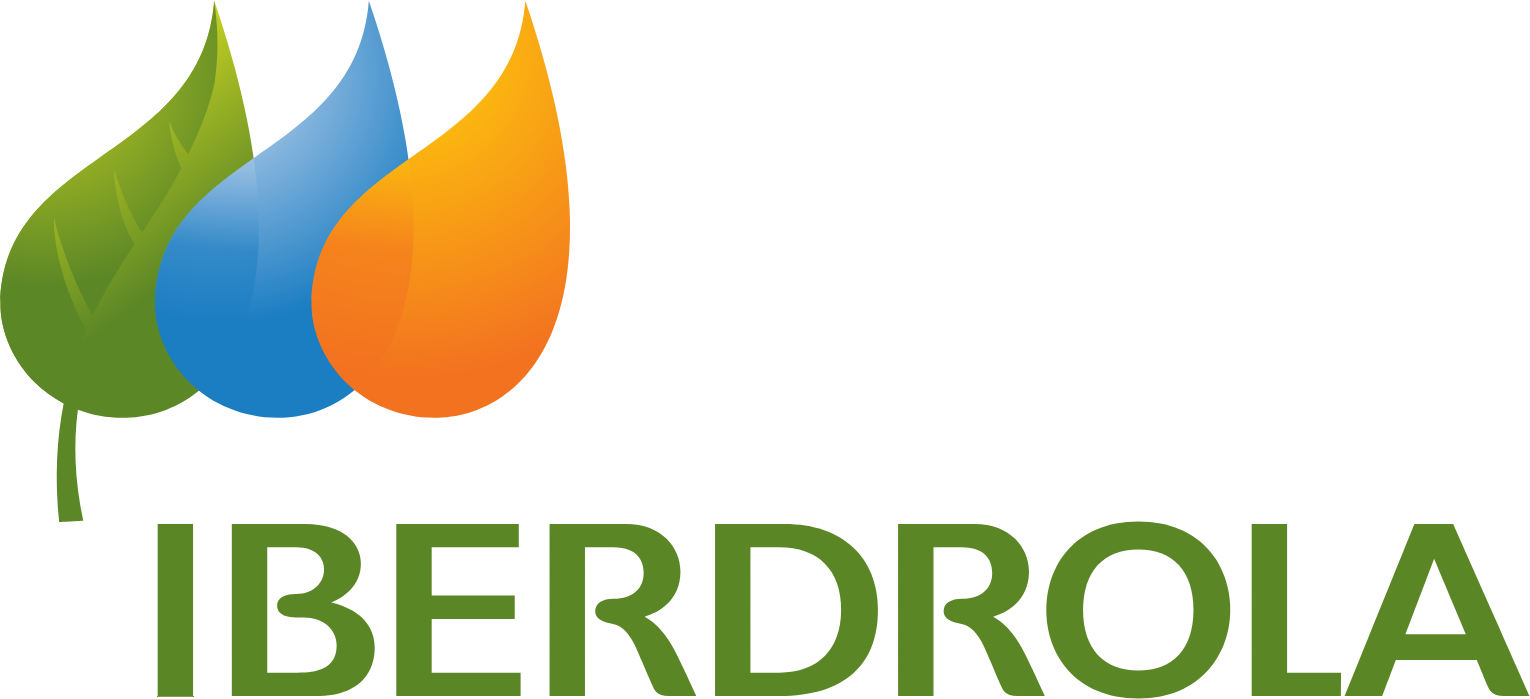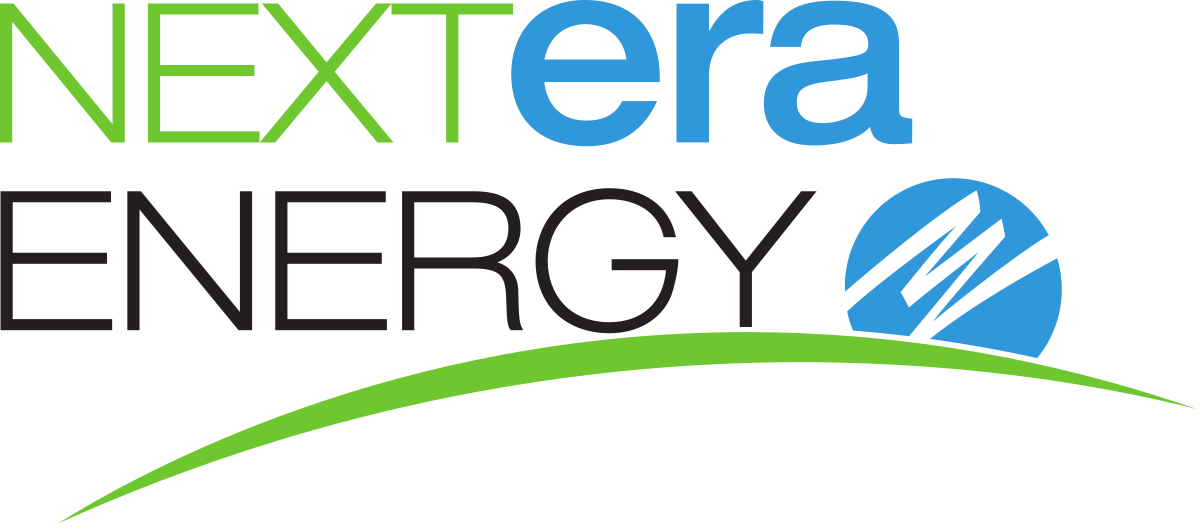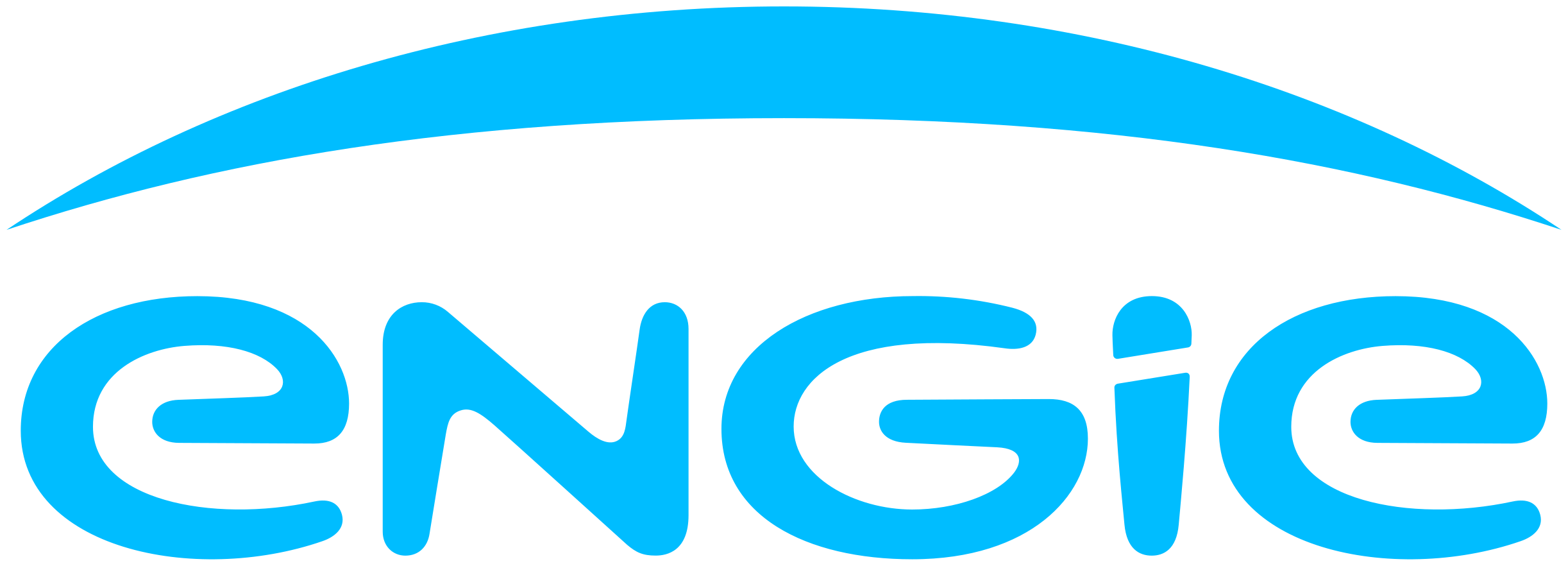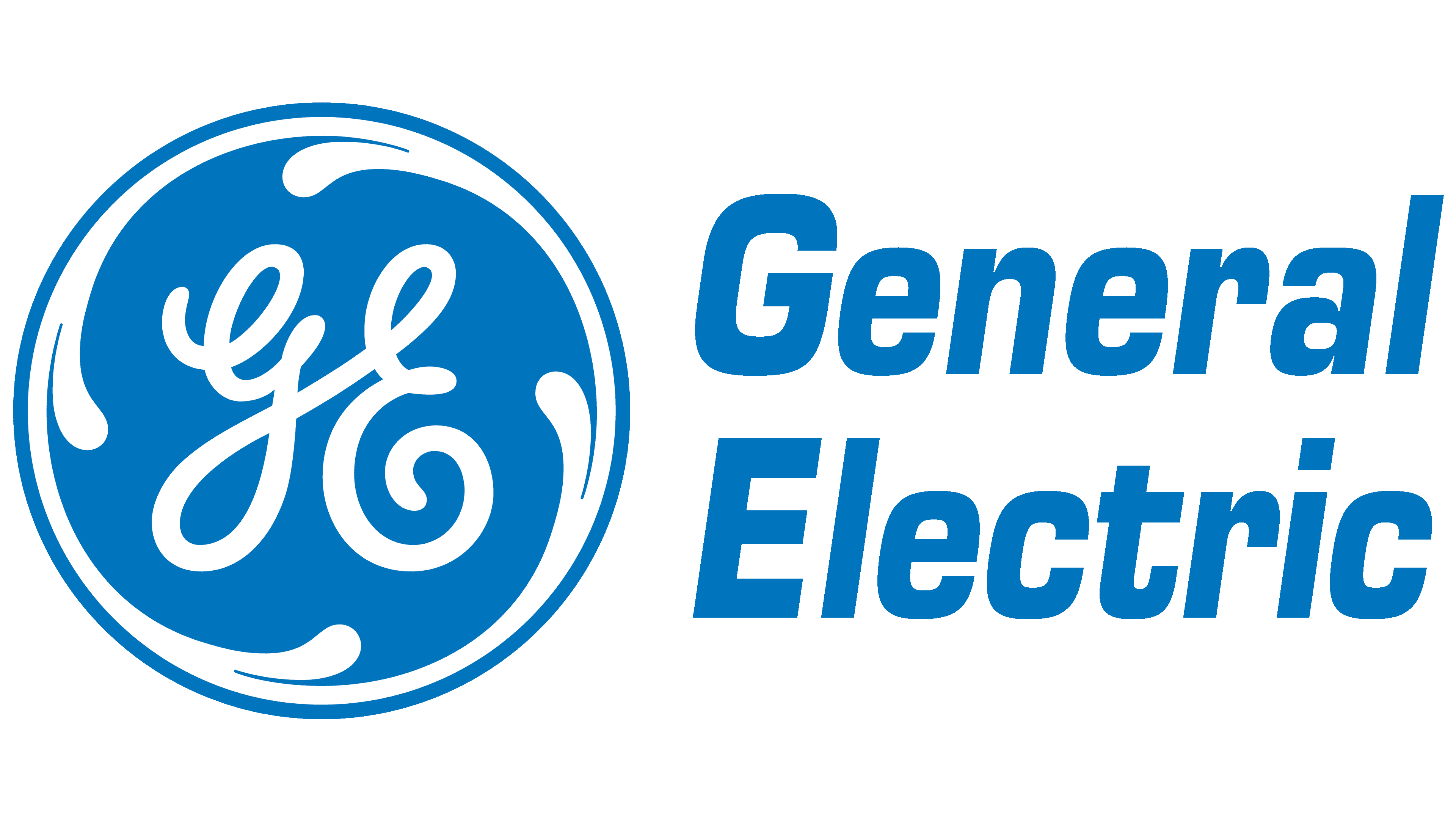Global Green Hydrogen Market, By Production Method, By Application, By Technology, By Region & Segmental Insights Trends and Forecast By Value (US$ Bn & Volume in Kilotons), 2024 – 2034
- Industry: Energy & Power
- Report ID: TNR-110-1323
- Number of Pages: 420
- Table/Charts : Yes
- October, 2024
- Base Year : 2024
- No. of Companies : 10+
- No. of Countries : 29
- Views : 10054
- Covid Impact Covered: Yes
- War Impact Covered: Yes
- Formats : PDF, Excel, PPT
Green hydrogen is hydrogen produced using renewable energy sources, such as wind or solar, through water electrolysis. This clean energy solution is gaining traction globally due to its role in decarbonizing sectors like transport, industry, and energy. For example, in 2023, Germany’s steel industry began adopting green hydrogen to reduce emissions, replacing fossil fuels in steel production. The transport sector also benefits from green hydrogen, with Toyota and Hyundai introducing hydrogen-powered vehicles, offering an eco-friendly alternative to conventional cars.
Countries like India are increasing green hydrogen adoption, with a goal to produce 5 million tons annually by 2030. As governments and companies invest more in green hydrogen infrastructure, its use in daily life powering homes, industries, and transport continues to expand, addressing both climate change and energy security concerns. “The Global Green Hydrogen Market Generated Revenue of US$ 4.9 Billion in 2023 and US$ 160.5 Billion in 2034 and is Expected to Grow at a CAGR of 37.2% from 2024 to 2034.”
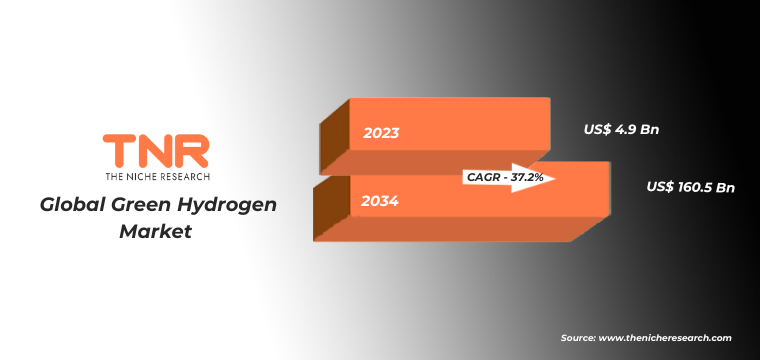
Hydrogen Production Cost:
Hydrogen production costs have significantly evolved over the years. In 2020, the average cost of green hydrogen was around $5.50 per kilogram, primarily due to high renewable energy prices and electrolyzer costs. By 2030, advancements in technology and economies of scale are expected to reduce costs to approximately $2 per kilogram, driven by increased renewable energy capacity and initiatives like the European Union’s Hydrogen Strategy, launched in 2020. Looking further ahead to 2050, costs could plummet to as low as $1 per kilogram, as seen in reports by BloombergNEF in 2022, making hydrogen a competitive fuel source for various applications, including transportation and industry.

Green Hydrogen Market Dynamic:
Growth Drivers-
- Government Initiatives and Policies: Governments worldwide are driving the green hydrogen market through supportive policies and funding. In 2021, the European Union launched its Hydrogen Strategy to boost hydrogen production, targeting 40 GW of electrolysers by 2030. Similarly, India announced a $2 billion Green Hydrogen Mission in 2023 to scale up production.
- Decarbonization Efforts Across Industries: Industries like steel and chemicals are increasingly adopting green hydrogen to reduce carbon emissions. In 2023, ArcelorMittal began using green hydrogen in its steel production to meet stringent climate goals. This trend is supported by companies like Air Liquide, which is expanding green hydrogen projects to decarbonize industrial processes.
- Technological Advancements and Cost Reduction: Technological innovations in electrolyzers are lowering green hydrogen production costs. For example, in 2022, Siemens Energy introduced more efficient electrolyzers that reduced the cost of hydrogen production. These advancements are crucial in making green hydrogen commercially viable, encouraging wider adoption across sectors like transport and energy.
Challenges-
- High Production Costs: Green hydrogen production remains expensive due to the high cost of renewable energy and electrolyzers. For instance, in 2022, the International Energy Agency (IEA) reported that producing green hydrogen was two to three times more costly than conventional hydrogen, limiting its commercial competitiveness in various sectors.
- Limited Infrastructure: The lack of infrastructure for green hydrogen storage and distribution poses significant challenges. In 2023, the U.S. Hydrogen Council highlighted gaps in hydrogen pipelines and refueling stations, particularly for large-scale deployment in transportation. Without significant investment, widespread adoption across industries like transport and energy remains constrained.
- Energy-Intensive Production Process: Producing green hydrogen requires vast amounts of renewable energy. For example, in 2021, a BloombergNEF report noted that meeting global green hydrogen demand would require more than double the world’s current renewable energy capacity. Scaling up renewable energy generation is crucial to support hydrogen growth, but it’s a daunting challenge.
Green Hydrogen Market Segmentation by Production Method, Application, Technology, Region
Electrolysis segment is set to dominate the green hydrogen market, commanding a substantial revenue share of 33.3% over the forecast period. Electrolysis, which uses renewable energy to split water into hydrogen and oxygen, is key to sustainable hydrogen production. In 2022, Siemens Energy expanded its electrolysis projects to supply green hydrogen to industries, helping drive this growth. Similarly, in 2023, Australia’s Fortescue Future Industries invested heavily in electrolyzer technology to produce green hydrogen on a large scale. As governments push for renewable solutions and industries aim for decarbonization, the adoption of electrolysis is accelerating, positioning it as a cornerstone of green hydrogen production.

Transportation dominated the global green hydrogen market, acquiring a revenue share of 25.5% in 2023. Green hydrogen is increasingly recognized as a clean alternative to fossil fuels in vehicles. For instance, Hyundai launched the Nexo, a hydrogen fuel cell vehicle, which has gained popularity in markets like California, promoting zero-emission transportation. In 2022, the world’s first hydrogen-powered passenger trains began operating in Germany, showcasing the potential of green hydrogen in public transport. As governments push for emission reductions, the demand for hydrogen-fueled buses and trucks is also rising, solidifying transportation’s role as a critical driver in the green hydrogen landscape.
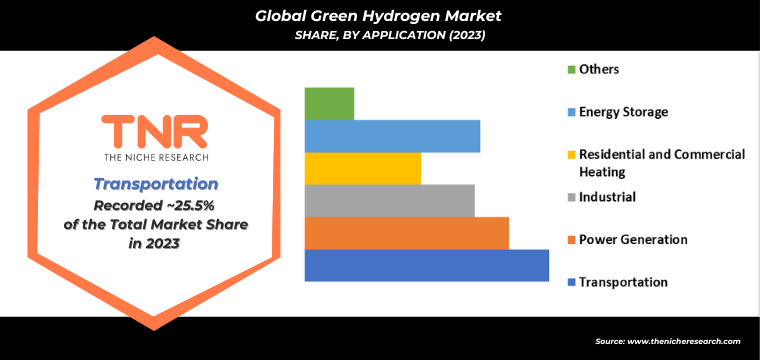
Polymer electrolyte membrane (PEM) electrolyzer segment is anticipated to be the fastest-growing application in the green hydrogen market, capturing a substantial revenue share of 30.5% over the forecast period. PEM electrolyzers offer high efficiency and quick response times, making them ideal for integrating renewable energy sources like wind and solar. For instance, in 2023, Plug Power announced plans to scale up its PEM technology to produce hydrogen at competitive costs, supporting the growing demand in various sectors. Additionally, in 2022, the European Union funded projects aimed at developing advanced PEM electrolyzers, reinforcing their pivotal role in achieving sustainable hydrogen production and addressing climate change challenges.
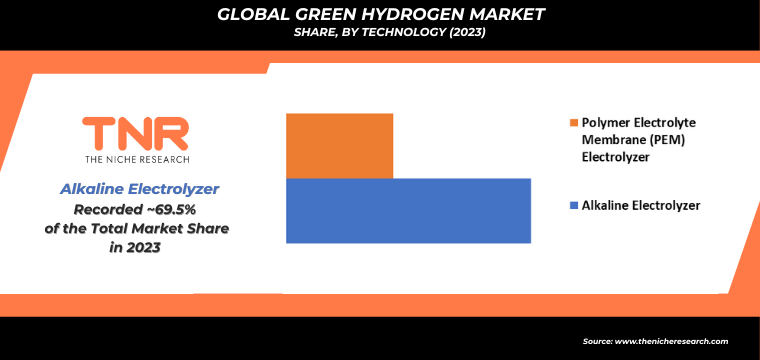
In 2023, North America is anticipated to play a significant role in propelling the growth of the green hydrogen market, contributing approximately 27.8% to its overall expansion. This growth is driven by substantial investments and supportive policies aimed at reducing carbon emissions. For example, the U.S. Department of Energy announced a $9 billion initiative in 2022 to promote clean hydrogen production, enhancing research and development efforts. Additionally, Canada has set ambitious targets for green hydrogen production, aiming to produce 1.5 million tons annually by 2030. Companies like Air Products are also investing heavily in North American hydrogen infrastructure, further solidifying the region’s position as a leader in the green hydrogen landscape.
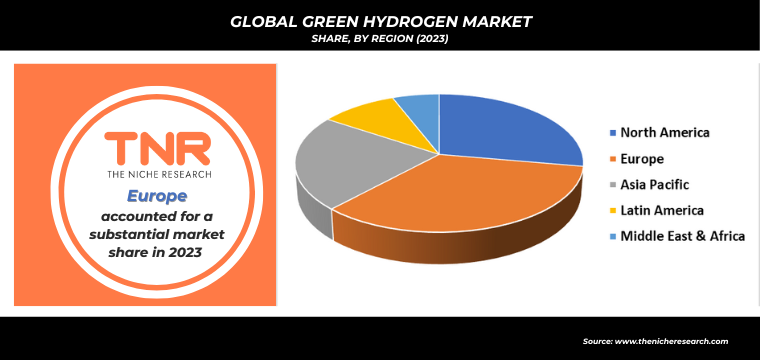
Major Players in Green Hydrogen Market
- Air Liquide
- Air Products Inc.
- Bloom Energy
- Cummins Inc.
- Engie
- Linde plc.
- Nel ASA
- Siemens Energy
- Toshiba Energy Systems & Solutions Corporation
- Uniper SE
- Other Industry Participants
Global Green Hydrogen Market Scope:
| Report Specifications | Details |
| Market Revenue in 2023 | US$ 4.9 Bn |
| Market Size Forecast by 2034 | US$ 160.5 Bn |
| Growth Rate (CAGR) | 37.2% |
| Historic Data | 2016 – 2022 |
| Base Year for Estimation | 2023 |
| Forecast Period | 2024 – 2034 |
| Report Inclusions | Market Size & Estimates, Market Dynamics, Competitive Scenario, Trends, Growth Factors, Market Determinants, Key Investment Segmentation, Product/Service/Solutions Benchmarking |
| Segments Covered | By Production Method, By Application, By Technology, By Region |
| Regions Covered | North America, Europe, Asia Pacific, Middle East & Africa, Latin America |
| Countries Covered | U.S., Canada, Mexico, Rest of North America, France, The UK, Spain, Germany, Italy, Nordic Countries (Denmark, Finland, Iceland, Sweden, Norway), Benelux Union (Belgium, The Netherlands, Luxembourg), Rest of Europe, China, Japan, India, New Zealand, Australia, South Korea, Southeast Asia (Indonesia, Thailand, Malaysia, Singapore, Rest of Southeast Asia), Rest of Asia Pacific, Saudi Arabia, UAE, Egypt, Kuwait, South Africa, Rest of Middle East & Africa, Brazil, Argentina, Rest of Latin America |
| Key Players | Air Liquide, Air Products Inc., Bloom Energy, Cummins Inc., Engie, Linde plc., Nel ASA, Siemens Energy, Toshiba Energy Systems & Solutions Corporation, Uniper SE |
| Customization Scope | Customization allows for the inclusion/modification of content pertaining to geographical regions, countries, and specific market segments. |
| Pricing & Procurement Options | Explore purchase options tailored to your specific research requirements |
| Contact Details | Consult With Our Expert
Japan (Toll-Free): +81 663-386-8111 South Korea (Toll-Free): +82-808- 703-126 Saudi Arabia (Toll-Free): +966 800-850-1643 United Kingdom: +44 753-710-5080 United States: +1 302-232-5106 E-mail: askanexpert@thenicheresearch.com
|
Global Green Hydrogen Market
By Production Method
- Electrolysis
- Alkaline Electrolysis
- Proton Exchange Membrane (PEM) Electrolysis
- Solid Oxide Electrolysis
- Biomass Gasification
- Photoelectrochemical Water Splitting
- Thermochemical Water Splitting
- Others
By Application
- Transportation
- Power Generation
- Industrial
- Residential and Commercial Heating
- Energy Storage
- Others
By Technology
- Alkaline Electrolyzer
- Polymer Electrolyte Membrane (PEM) Electrolyzer
By Region
- North America (U.S., Canada, Mexico, Rest of North America)
- Europe (France, The UK, Spain, Germany, Italy, Nordic Countries (Denmark, Finland, Iceland, Sweden, Norway), Benelux Union (Belgium, The Netherlands, Luxembourg), Rest of Europe)
- Asia Pacific (China, Japan, India, New Zealand, Australia, South Korea, Southeast Asia (Indonesia, Thailand, Malaysia, Singapore, Rest of Southeast Asia), Rest of Asia Pacific)
- Middle East & Africa (Saudi Arabia, UAE, Egypt, Kuwait, South Africa, Rest of Middle East & Africa)
- Latin America (Brazil, Argentina, Rest of Latin America)
Report Layout:
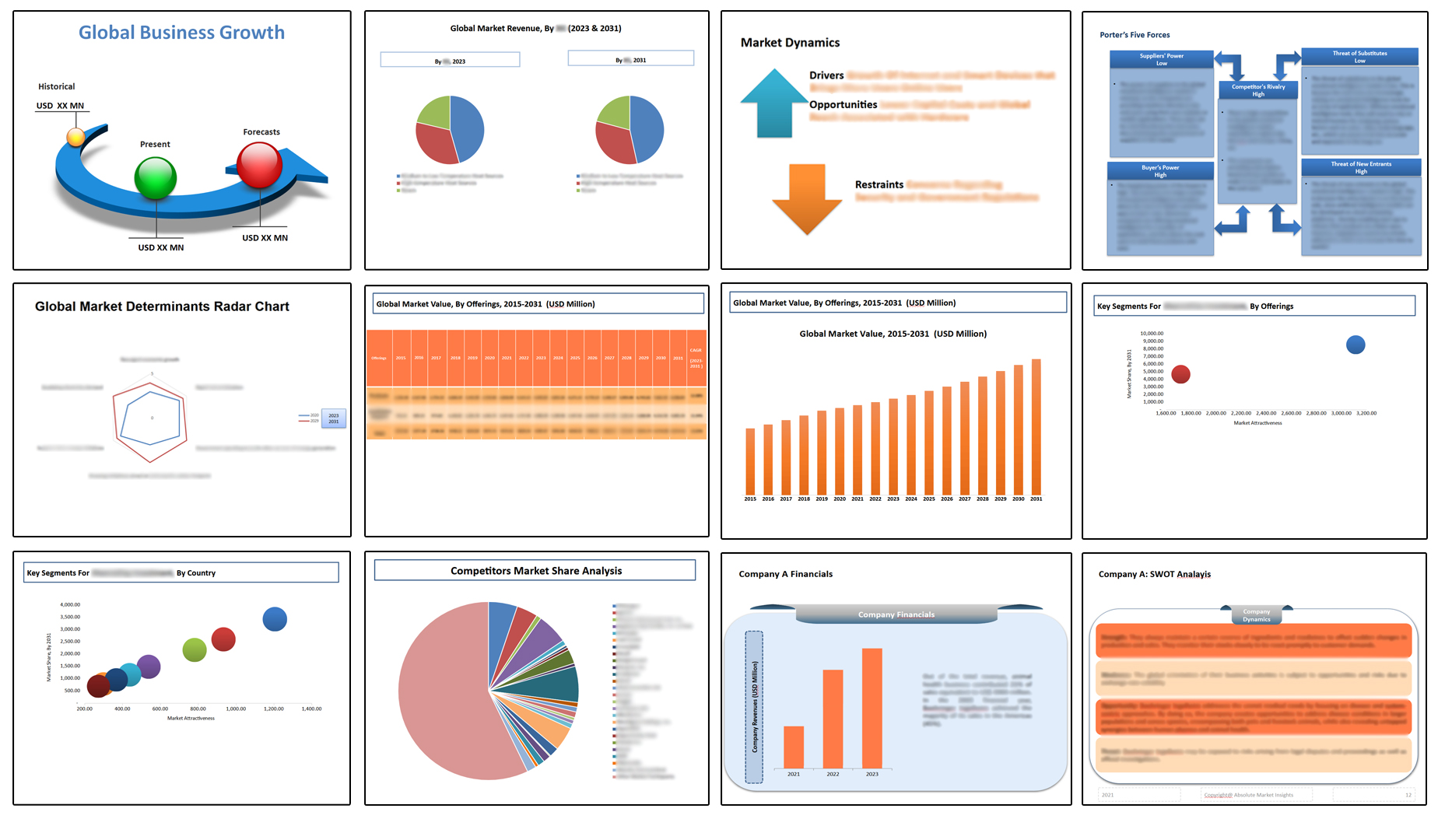
Table of Contents
Note: This ToC is tentative and can be changed according to the research study conducted during the course of report completion.
**Exclusive for Multi-User and Enterprise User.
Global Green Hydrogen Market
By Production Method
- Electrolysis
- Alkaline Electrolysis
- Proton Exchange Membrane (PEM) Electrolysis
- Solid Oxide Electrolysis
- Biomass Gasification
- Photoelectrochemical Water Splitting
- Thermochemical Water Splitting
- Others
By Application
- Transportation
- Power Generation
- Industrial
- Residential and Commercial Heating
- Energy Storage
- Others
By Technology
- Alkaline Electrolyzer
- Polymer Electrolyte Membrane (PEM) Electrolyzer
By Region
- North America (U.S., Canada, Mexico, Rest of North America)
- Europe (France, The UK, Spain, Germany, Italy, Nordic Countries (Denmark, Finland, Iceland, Sweden, Norway), Benelux Union (Belgium, The Netherlands, Luxembourg), Rest of Europe)
- Asia Pacific (China, Japan, India, New Zealand, Australia, South Korea, Southeast Asia (Indonesia, Thailand, Malaysia, Singapore, Rest of Southeast Asia), Rest of Asia Pacific)
- Middle East & Africa (Saudi Arabia, UAE, Egypt, Kuwait, South Africa, Rest of Middle East & Africa)
- Latin America (Brazil, Argentina, Rest of Latin America)
The Niche Research approach encompasses both primary and secondary research methods to provide comprehensive insights. While primary research is the cornerstone of our studies, we also incorporate secondary research sources such as company annual reports, premium industry databases, press releases, industry journals, and white papers.
Within our primary research, we actively engage with various industry stakeholders, conducting paid interviews and surveys. Our meticulous analysis extends to every market participant in major countries, allowing us to thoroughly examine their portfolios, calculate market shares, and segment revenues.
Our data collection primarily focuses on individual countries within our research scope, enabling us to estimate regional market sizes. Typically, we employ a bottom-up approach, meticulously tracking trends in different countries. We analyze growth drivers, constraints, technological innovations, and opportunities for each country, ultimately arriving at regional figures.Our process begins by examining the growth prospects of each country. Building upon these insights, we project growth and trends for the entire region. Finally, we utilize our proprietary model to refine estimations and forecasts.
Our data validation standards are integral to ensuring the reliability and accuracy of our research findings. Here’s a breakdown of our data validation processes and the stakeholders we engage with during our primary research:
- Supply Side Analysis: We initiate a supply side analysis by directly contacting market participants, through telephonic interviews and questionnaires containing both open-ended and close-ended questions. We gather information on their portfolios, segment revenues, developments, and growth strategies.
- Demand Side Analysis: To gain insights into adoption trends and consumer preferences, we reach out to target customers and users (non-vendors). This information forms a vital part of the qualitative analysis section of our reports, covering market dynamics, adoption trends, consumer behavior, spending patterns, and other related aspects.
- Consultant Insights: We tap into the expertise of our partner consultants from around the world to obtain their unique viewpoints and perspectives. Their insights contribute to a well-rounded understanding of the markets under investigation.
- In-House Validation: To ensure data accuracy and reliability, we conduct cross-validation of data points and information through our in-house team of consultants and utilize advanced data modeling tools for thorough verification.
The forecasts we provide are based on a comprehensive assessment of various factors, including:
- Market Trends and Past Performance (Last Five Years): We accurately analyze market trends and performance data from preceding five years to identify historical patterns and understand the market’s evolution.
- Historical Performance and Growth of Market Participants: We assess the historical performance and growth trajectories of key market participants. This analysis provides insights into the competitive landscape and individual company strategies.
- Market Determinants Impact Analysis (Next Eight Years): We conduct a rigorous analysis of the factors that are projected to influence the market over the next eight years. This includes assessing both internal and external determinants that can shape market dynamics.
- Drivers and Challenges for the Forecast Period:Identify the factors expected to drive market growth during the forecast period, as well as the challenges that the industry may face. This analysis aids in deriving an accurate growth rate projection.
- New Acquisitions, Collaborations, or Partnerships: We keep a close watch on any new acquisitions, collaborations, or partnerships within the industry. These developments can have a significant impact on market dynamics and competitiveness.
- Macro and Micro Factors Analysis:A thorough examination of both macro-level factors (e.g., economic trends, regulatory changes) and micro-level factors (e.g., technological advancements, consumer preferences) that may influence the market during the forecast period.
- End-User Sentiment Analysis: To understand the market from the end-user perspective, we conduct sentiment analysis. This involves assessing the sentiment, preferences, and feedback of the end-users, which can provide valuable insights into market trends.
- Perspective of Primary Participants: Insights gathered directly from primary research participants play a crucial role in shaping our forecasts. Their perspectives and experiences provide valuable qualitative data.
- Year-on-Year Growth Trend: We utilize a year-on-year growth trend based on historical market growth and expected future trends. This helps in formulating our growth projections, aligning them with the market’s historical performance.
Research process adopted by TNR involves multiple stages, including data collection, validation, quality checks, and presentation. It’s crucial that the data and information we provide add value to your existing market understanding and expertise. We have also established partnerships with business consulting, research, and survey organizations across regions and globally to collaborate on regional analysis and data validation, ensuring the highest level of accuracy and reliability in our reports.
